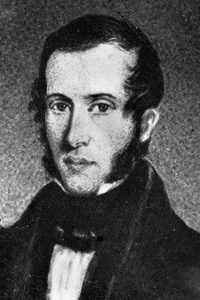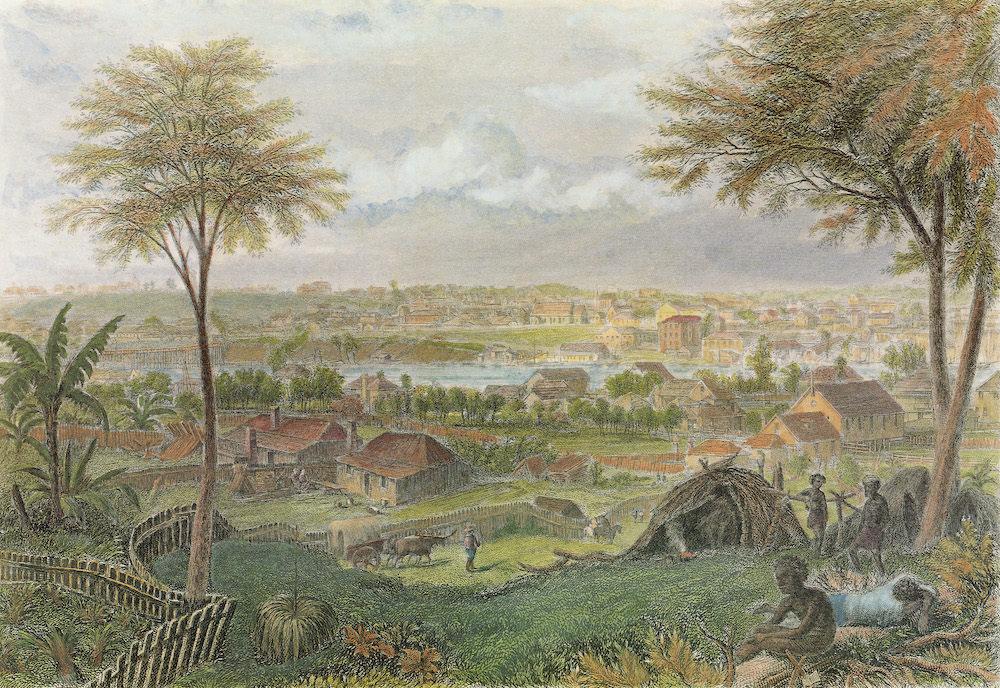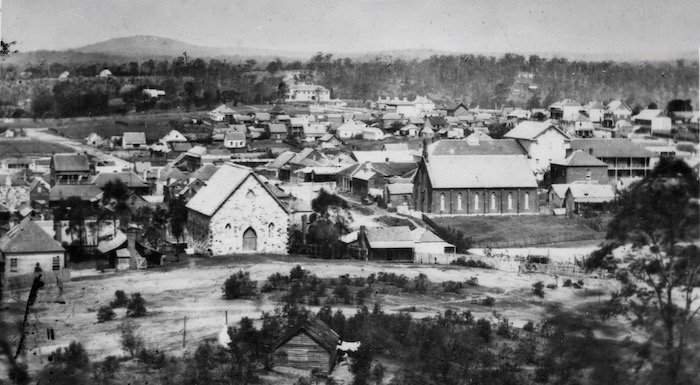Thomas Mowbray was born to Matthew Mowbray, an ironmonger and his wife Jane (nee Miller) in 1812, at Hamilton, Lanarkshire, Scotland.
He entered the University of Glasgow in 1829 and graduated with an M.A. in 1834. He became the assistant to Rev. Dr. Keith in Hamilton and later ordained as minister of the Quoad Saera Church at Blackridge.
He married Williamina Anderson at West Colinton (Edinburgh, Scotland) on 17th August 1841.
They had nine children, all born in Australia: Elizabeth (b. 1842), Jane (b. 1844), Margaret (b. 1846), Thomas (b. 1848), Matthew (b. 1850), Ada (b. 1853), John (b. 1855.), James (b. 1857) and Mabel (b. 1860).
For the sake of his health, they emigrated to Australia, arriving in 1842. For three years, Thomas Mowbray was minister at Campbellfield in the Port Phillip district of the colony of NSW, but due to his ill health moved further north to Sydney. During the next two and a half years his health deteriorated further and in 1847 they moved north again to Moreton Bay.
From the time of his arrival in Moreton Bay he was active in establishing a Protestant church. Differences in doctrine lead to separate churches and he then worked on several committees to establish a Presbyterian Church. These early churches were based on the northern side of the Brisbane River. Services on the southern side were taken by a minister who was rowed across the river.
Rev. Mowbray purchased land on the southern side of the Brisbane River, opposite New Farm. He built a stone house called Riversdale (c.1850) and conducted a school there. This area is still named Mowbray Park. With a growing congregation on the south side of the river, he saw the need for a church with its own minister and began to work towards achieving this.
Because of his involvement he is referred to by many historians as the Father of Presbyterianism in Queensland.
He died on the 24th December 1867 at the age of 55.
The district name of Mowbraytown originated in 1884 when Williamina Mowbray, the wife of the late Rev Thomas Mowbray, sold the land between Lytton Rd and Mowbray Terrace to Josiah Young who subdivided this area into 336 residential allotments. This area then became known as the Mowbraytown Estate. Mowbray Park retained its name on the river side of Lytton Rd.
Williamina later donated land in Mowbray Terrace for the building of the Mowbraytown Church and Hall. His children were active members of its congregation in its early years.
The area known as East Brisbane originally came about in the late 1800’s when a “workers settlement” grew at the end of Kangaroo Point on the eastern edge of South Brisbane. During this time Brisbane Town was expanding and a number of satellite districts were being developed. Along with other pioneering districts the area known as Mowbraytown was ultimately absorbed into the comprehensive name of East Brisbane.
( text: Geraint Gregory)
Reverend Thomas Mowbray opened the first Presbyterian Church in Queensland, in Grey Street, South Brisbane.
On 25 May 1851 the first Presbyterian Church in Queensland [then Moreton Bay Settlement] was opened by the Rev.Thomas Mowbray, who became known as the ‘Father’ of Presbyterianism in Queensland.

He was a Minister of the Established Church of Scotland who migrated in 1842 to NSW for health reasons. When his health deteriorated further he moved north to Moreton Bay, arriving in 1847. He bought eleven acres of riverfront land in what was then Kangaroo Point and in 1851 built a beautiful stone house called ‘Riversdale’, establishing the second ‘riverine estate’ in the colony (after Newstead House). The area is now Mowbray Park.
He became actively involved in establishing a Presbyterian Church as many of the Presbyterian Scots who had come out in 1849 on Dr Lang’s immigrant boats the Fortitude, Chaseley and the Lima no longer wanted to attend combined services with other denominations and wanted their own church.
After an initial planning meeting of prominent ‘Presbyters’ at his home in October 1849, a second meeting was held on 12 December at which a pioneer committee was formed to establish the Church. Chairman was D.C. McConnel of Cressbrook and Shafston House, Rev. Mowbray was secretary and members included Messrs. Boyland, Cairncross, Graham, Gray, Inglis, McIntyre, McLean, McNaught and Stewart. In February 1850 they bought a block of land in Grey Street, South Brisbane, in the names of McConnel, Mowbray, Cairncross, Gray and McIntyre and in March accepted a tender for £112 from John Graham to build a small wooden church on the site.

This view of Brisbane is from the southern part of the Expo 88 site on the South Bank of the Brisbane River. The right foreground depicts the Presbyterian Church built in 1851 in Grey Street, South Brisbane, which remained in use until the erection of the Park Presbyterian Church. (excerpt from description, State Library of Queensland)
The church was completed in early 1851 and officially opened by Rev. Mowbray on 25 May. He conducted the first service and continued until a permanent minister Rev. Walter Ross McLeod, was appointed in August. Soon evening services were also held on the north side in the School of Arts Building corner Queen and Creek Streets. However, due to increasing ill health Rev. McLeod returned to England a year later. Rev. Mowbray filled the gap until 1853 when the Rev. Sinclair arrived, but he only stayed for two years.
It was soon becoming clear that a church was needed on the north side. In February1854 land was bought in Ann Street and Rev. Charles Ogg appointed to look after both the south and north side. He considered the north side to be more suitable and encouraged south side members to worship there, which led to increasing tensions between the two groups. In May 1857 it was decided to divide the congregations. Some south side members moved to the north side and construction started on the Ann Street site. The new Ann Street Presbyterian Church was opened in 1858. On 21 December 1871 a fire almost destroyed the church, leaving only the stone walls. It was rebuilt the following year and has had many alterations and extensions since then.

The South Brisbane Presbyterian Church in Glenelg Street, South Brisbane, ca. 1885. (State Library of Queensland)
Despite extensions and alterations the original church in Grey Street no longer met the needs of the growing congregation on the south side. In 1880 a block on the corner of Cordelia and Glenelg Streets opposite Musgrave Park was bought for £175 and a more substantial and attractive building planned.

The foundation stone was laid in October 1884 and on 11 October 1885 the South Brisbane Presbyterian Church, designed by Colonial Architect F.D.G. Stanley, was formally opened. It was later called the Park Presbyterian Church.
The old church building in Grey Street was sold to a private company and used for storage. It was demolished after the site was resumed for construction of the Melbourne Street Railway Station (now South Brisbane Railway Station) which opened in 1884. (Heritage Register/Trove articles)

